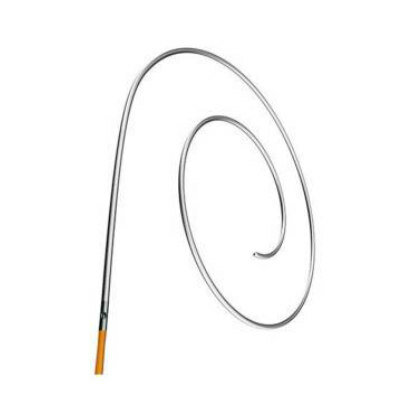Designing COVID-19 Vaccine That Partially Mimics Structure Of SARS-CoV-2 Virus Could Increase Its Effectiveness
|
By HospiMedica International staff writers Posted on 29 Oct 2020 |

Image: A close-up view of the RBD particle vaccine (green) (Photo courtesy of McGill University)
A research team at University at Buffalo (Buffalo, NY, USA) has discovered a technique that could help increase the effectiveness of vaccines against the novel coronavirus, the virus that causes COVID-19.
Amidst active efforts to develop an effective COVID-19 vaccine, the University at Buffalo-led research team believes that one answer might lie in designing vaccines that partially mimic the structure of the virus. One of the proteins on the virus - located on the characteristic COVID spike has a component called the receptor-binding domain, or RBD, which is its “Achilles heel.” Antibodies against this part of the virus have the potential to neutralize the virus. The team hypothesized that by converting the RBD into a nanoparticle (similar in size to the virus itself) instead of letting it remain in its natural form as a small protein, it would generate higher levels of neutralizing antibodies and its ability to generate an immune response would increase.
The team had previously developed a technology that makes it easy to convert small, purified proteins into particles through the use of liposomes, or small nanoparticles formed from naturally-occurring fatty components. In the new study, the researchers included within the liposomes a special lipid called cobalt-porphyrin-phospholipid, or CoPoP. That special lipid enables the RBD protein to rapidly bind to the liposomes, forming more nanoparticles that generate an immune response. The team observed that when the RBD was converted into nanoparticles, it maintained its correct, three-dimensional shape and the particles were stable in incubation conditions similar to those in the human body. When laboratory mice and rabbits were immunized with the RBD particles, high antibody levels were induced. Compared to other materials that are combined with the RBD to enhance the immune response, only the approach with particles containing CoPoP gave strong responses. Other vaccine adjuvant technology does not have the capacity to convert the RBD into particle-form, according to the researchers.
“We think these results provide evidence to the vaccine-development community that the RBD antigen benefits a lot from being in particle format. This could help inform future vaccine design that targets this specific antigen,” said Jonathan F. Lovell, PhD, associate professor in the Department of Biomedical Engineering at UB, the primary investigator on the research.
Related Links:
University at Buffalo
Amidst active efforts to develop an effective COVID-19 vaccine, the University at Buffalo-led research team believes that one answer might lie in designing vaccines that partially mimic the structure of the virus. One of the proteins on the virus - located on the characteristic COVID spike has a component called the receptor-binding domain, or RBD, which is its “Achilles heel.” Antibodies against this part of the virus have the potential to neutralize the virus. The team hypothesized that by converting the RBD into a nanoparticle (similar in size to the virus itself) instead of letting it remain in its natural form as a small protein, it would generate higher levels of neutralizing antibodies and its ability to generate an immune response would increase.
The team had previously developed a technology that makes it easy to convert small, purified proteins into particles through the use of liposomes, or small nanoparticles formed from naturally-occurring fatty components. In the new study, the researchers included within the liposomes a special lipid called cobalt-porphyrin-phospholipid, or CoPoP. That special lipid enables the RBD protein to rapidly bind to the liposomes, forming more nanoparticles that generate an immune response. The team observed that when the RBD was converted into nanoparticles, it maintained its correct, three-dimensional shape and the particles were stable in incubation conditions similar to those in the human body. When laboratory mice and rabbits were immunized with the RBD particles, high antibody levels were induced. Compared to other materials that are combined with the RBD to enhance the immune response, only the approach with particles containing CoPoP gave strong responses. Other vaccine adjuvant technology does not have the capacity to convert the RBD into particle-form, according to the researchers.
“We think these results provide evidence to the vaccine-development community that the RBD antigen benefits a lot from being in particle format. This could help inform future vaccine design that targets this specific antigen,” said Jonathan F. Lovell, PhD, associate professor in the Department of Biomedical Engineering at UB, the primary investigator on the research.
Related Links:
University at Buffalo
Latest COVID-19 News
- Low-Cost System Detects SARS-CoV-2 Virus in Hospital Air Using High-Tech Bubbles
- World's First Inhalable COVID-19 Vaccine Approved in China
- COVID-19 Vaccine Patch Fights SARS-CoV-2 Variants Better than Needles
- Blood Viscosity Testing Can Predict Risk of Death in Hospitalized COVID-19 Patients
- ‘Covid Computer’ Uses AI to Detect COVID-19 from Chest CT Scans
- MRI Lung-Imaging Technique Shows Cause of Long-COVID Symptoms
- Chest CT Scans of COVID-19 Patients Could Help Distinguish Between SARS-CoV-2 Variants
- Specialized MRI Detects Lung Abnormalities in Non-Hospitalized Long COVID Patients
- AI Algorithm Identifies Hospitalized Patients at Highest Risk of Dying From COVID-19
- Sweat Sensor Detects Key Biomarkers That Provide Early Warning of COVID-19 and Flu
- Study Assesses Impact of COVID-19 on Ventilation/Perfusion Scintigraphy
- CT Imaging Study Finds Vaccination Reduces Risk of COVID-19 Associated Pulmonary Embolism
- Third Day in Hospital a ‘Tipping Point’ in Severity of COVID-19 Pneumonia
- Longer Interval Between COVID-19 Vaccines Generates Up to Nine Times as Many Antibodies
- AI Model for Monitoring COVID-19 Predicts Mortality Within First 30 Days of Admission
- AI Predicts COVID Prognosis at Near-Expert Level Based Off CT Scans
Channels
Critical Care
view channel
CPR Guidelines Updated for Pediatric and Neonatal Emergency Care and Resuscitation
Cardiac arrest in infants and children remains a leading cause of pediatric emergencies, with more than 7,000 out-of-hospital and 20,000 in-hospital cardiac arrests occurring annually in the United States.... Read more
Ingestible Capsule Monitors Intestinal Inflammation
Acute mesenteric ischemia—a life-threatening condition caused by blocked blood flow to the intestines—remains difficult to diagnose early because its symptoms often mimic common digestive problems.... Read more
Wireless Implantable Sensor Enables Continuous Endoleak Monitoring
Endovascular aneurysm repair (EVAR) is a life-saving, minimally invasive treatment for abdominal aortic aneurysms—balloon-like bulges in the aorta that can rupture with fatal consequences.... Read more
Wearable Patch for Early Skin Cancer Detection to Reduce Unnecessary Biopsies
Skin cancer remains one of the most dangerous and common cancers worldwide, with early detection crucial for improving survival rates. Traditional diagnostic methods—visual inspections, imaging, and biopsies—can... Read moreSurgical Techniques
view channel
Robotic Assistant Delivers Ultra-Precision Injections with Rapid Setup Times
Age-related macular degeneration (AMD) is a leading cause of blindness worldwide, affecting nearly 200 million people, a figure expected to rise to 280 million by 2040. Current treatment involves doctors... Read more
Minimally Invasive Endoscopic Surgery Improves Severe Stroke Outcomes
Intracerebral hemorrhage, a type of stroke caused by bleeding deep within the brain, remains one of the most challenging neurological emergencies to treat. Accounting for about 15% of all strokes, it carries... Read morePatient Care
view channel
Revolutionary Automatic IV-Line Flushing Device to Enhance Infusion Care
More than 80% of in-hospital patients receive intravenous (IV) therapy. Every dose of IV medicine delivered in a small volume (<250 mL) infusion bag should be followed by subsequent flushing to ensure... Read more
VR Training Tool Combats Contamination of Portable Medical Equipment
Healthcare-associated infections (HAIs) impact one in every 31 patients, cause nearly 100,000 deaths each year, and cost USD 28.4 billion in direct medical expenses. Notably, up to 75% of these infections... Read more
Portable Biosensor Platform to Reduce Hospital-Acquired Infections
Approximately 4 million patients in the European Union acquire healthcare-associated infections (HAIs) or nosocomial infections each year, with around 37,000 deaths directly resulting from these infections,... Read moreFirst-Of-Its-Kind Portable Germicidal Light Technology Disinfects High-Touch Clinical Surfaces in Seconds
Reducing healthcare-acquired infections (HAIs) remains a pressing issue within global healthcare systems. In the United States alone, 1.7 million patients contract HAIs annually, leading to approximately... Read moreHealth IT
view channel
Printable Molecule-Selective Nanoparticles Enable Mass Production of Wearable Biosensors
The future of medicine is likely to focus on the personalization of healthcare—understanding exactly what an individual requires and delivering the appropriate combination of nutrients, metabolites, and... Read moreBusiness
view channel
Philips and Masimo Partner to Advance Patient Monitoring Measurement Technologies
Royal Philips (Amsterdam, Netherlands) and Masimo (Irvine, California, USA) have renewed their multi-year strategic collaboration, combining Philips’ expertise in patient monitoring with Masimo’s noninvasive... Read more
B. Braun Acquires Digital Microsurgery Company True Digital Surgery
The high-end microsurgery market in neurosurgery, spine, and ENT is undergoing a significant transformation. Traditional analog microscopes are giving way to digital exoscopes, which provide improved visualization,... Read more
CMEF 2025 to Promote Holistic and High-Quality Development of Medical and Health Industry
The 92nd China International Medical Equipment Fair (CMEF 2025) Autumn Exhibition is scheduled to be held from September 26 to 29 at the China Import and Export Fair Complex (Canton Fair Complex) in Guangzhou.... Read more















